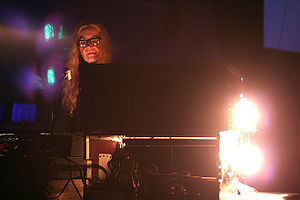- Maryanne Amacher
-
Maryanne Amacher (February 25, 1938[1][2] – October 22, 2009) was an American composer and installation artist.
Contents
Biography
Amacher was born in Kane, Pennsylvania,[1] to an American nurse and a Swiss freight train worker. As the only child, she grew up playing the piano. Amacher left Kane to attend the University of Pennsylvania on a full scholarship where she received a B.F.A in 1964.[1] While there she studied composition with George Rochberg[1] and Karlheinz Stockhausen. Subsequently, she did graduate work in acoustics and computer science at the University of Illinois at Urbana-Champaign.
While in residence at the University of Buffalo, in 1967, she created City Links: Buffalo, a 28-hour piece using 5 microphones in different parts of the city, broadcast live by radio station WBFO. There were 21 other pieces in the "City Links" series, though many details are not yet known. A common feature was the use of dedicated, FM radio quality telephone (0-15,000 Hz range) lines to connect the sound environments of different sites into the same space, a very early example of what is now called "telematic performance" and preceded much more famous examples of this by Max Neuhaus and others. Neuhaus was involved with the original '67 work in Buffalo.
Her major pieces have almost exclusively been site specific,[1] often using many loudspeakers to create what she called "structure borne sound", which is a differentiation with "airborne sound", the paradox intentional. By using many diffuse sound sources (either not in the space or speakers facing at the walls or floors) she would create the psychoacoustic illusions of sound shapes/"precense". Amacher's early work is best represented in the three series of multimedia installations produced in the United States, Europe, and Japan: the sonic telepresence series, "CITY LINKS" 1-22 (1967- ); the architecturally staged "MUSIC FOR SOUND JOINED ROOMS" (1980- ) and the "MINI-SOUND SERIES" (1985- ) a new multimedia form which she created, that is unique in its use of architecture and serialized narrative.
She worked extensively with the physiological (not psychoacoustic) phenomenon called otoacoustic emission, in which the ears themselves act as sound generating devices. Amacher composed several "ear dances" designed to stimulate clear "third" tones coming from the listener's ears. It's not yet adequately researched and clear as to whether these works are solely from otoacoustic emissions or perhaps also combination and difference tones. The subtitle of her first Tzadik Records album Sound Characters (Making the Third Ear) references these "ear tones". Amacher describes this phenomenon:
When played at the right sound level, which is quite high and exciting, the tones in this music will cause your ears to act as neurophonic instruments that emit sounds that will seem to be issuing directly from your head ... (my audiences) discover they are producing a tonal dimension of the music which interacts melodically, rhythmically, and spatially with the tones in the room. Tones 'dance' in the immediate space of their body, around them like a sonic wrap, cascade inside ears, and out to space in front of their eyes ... Do not be alarmed! Your ears are not behaving strange or being damaged! ... these virtual tones are a natural and very real physical aspect of auditory perception, similar to the fusing of two images resulting in a third three dimensional image in binocular perception ... I want to release this music which is produced by the listener ...[3]Over the years she received several major commissions in the United States and Europe with occasional work in Asia and Central and South America. In 1998 she was awarded a grant from the Foundation for Contemporary Arts Grants to Artists Award. In 2005, she was awarded the Prix Ars Electronica (the Golden Nica) in the "Digital Musics" category for her project "TEO! A sonic sculpture". At the time of her death she had been working three years on a 40 channel piece commissioned by the Experimental Media and Performing Arts Center in Troy, New York.
She never held a full-time job after being a typist in the early 1960s. For the last decade of her life she taught at the Bard College MFA program.
Notes
- ^ a b c d e Allan Kozinn, Maryanne Amacher, 71, Visceral Composer, Dies, Obituary, The New York Times, 2009 Oct. 28.
- ^ Note, while most sources state Amacher's birth year as 1938, she had in later years used the birth year 1943.
- ^ "When played at the right sound level". Displaced Sounds. June 24, 2009. http://www.displacedsounds.com/?p=241.
References
- Andrew Kesin, "Day Trip Maryanne" (a documentary film of performance collaborations between Amacher and Thurston Moore)
External links
- The Maryanne Amacher Archive (primary sources and to support the preservation of her work): http://www.maryanneamacher.org
- Golden, Barbara. “Conversation with Maryanne Amacher.” eContact! 12.2 — Interviews (2) (April 2010). Montréal: CEC.
- Handelman, Eliot. “Interview with Maryanne Amacher. Ears as Instruments: Minds Making Shapes.” From approx. 1991. http://www.colba.net/~eliot/amacher.htm
- http://archive.futuresonic.com/sensesonic/archive/MARYANNE/msg-0001.html
Categories:- 1938 births
- 2009 deaths
- 20th-century classical composers
- 21st-century classical composers
- American composers
- Women composers
- American experimental musicians
- Musicians from New York
- Tzadik Records artists
Wikimedia Foundation. 2010.

